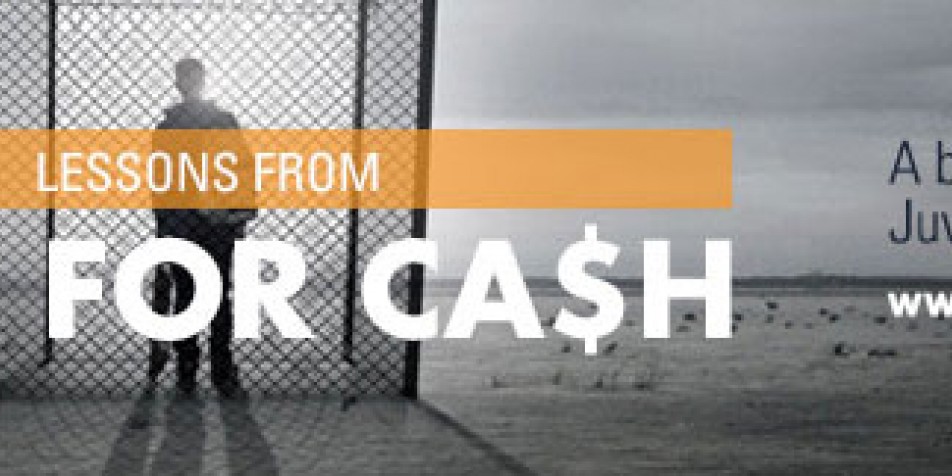Lessons from "Kids for Cash," Part 4: Zero-Tolerance Policies Make Zero Sense

In the wake of the Luzerne County, PA “kids-for-cash” scandal, convicted ex-juvenile court judges Mark Ciavarella and Michael Conahan bear most of the public blame for violating the rights of thousands of children. The judges sent many of those youth to private juvenile detention centers, and forever altered their lives. But we should not overlook the fact that many of those children ended up in Ciavarella’s courtroom because they were sent there by schools – the very institutions charged with caring for and teaching our children.
And what have they learned?
 Hillary Transue, photographed in Luzerne County in 2011
Hillary Transue, photographed in Luzerne County in 2011School officials called the police when Hillary Transue, age 14, created a fake MySpace page about her vice principal. They called the police when Amanda Lorah, age 14, got into a minor fight with another girl in the school gymnasium. They called the police when Justin Bodnar, age 12, got into a verbal altercation with a mother of another child at a school bus stop. School officials abdicated their responsibilities to Ciavarella and the juvenile justice system, turning typical adolescent misbehavior that should have been managed within the school system into a 911 call.
This severe approach to school discipline, known as “zero-tolerance,” is justified by its proponents as a response to tragic school shootings like Columbine. The facts show a different story. Most students like Hillary, Amanda and Justin are suspended, expelled and arrested for minor misbehavior, not for actual weapons offenses. Several schools recently made national headlines for suspending or expelling young children for even pretending to have a weapon, prompting one state to propose “pop tart” legislation.
Unnecessarily ushering children into the justice system has a lasting negative impact. Children suffer the shame and stigma of system involvement, experience long-term negative consequences of having a juvenile record, and lose connections with supportive adults and peers. Children also learn to distrust adults in positions of authority, and their belief in our justice system is destroyed. Luzerne County’s widespread acceptance of zero-tolerance policies greatly contributed to the scandal’s occurrence. These policies allowed Ciavarella to easily traffic children from schools to detention centers. Sadly, this problem is not unique to Luzerne County—it’s happening every day, all across the country.
The Obama Administration recently denounced the use of zero tolerance policies, issuing federal guidelines to schools as a means to end the school-to-prison pipeline. The guidance, issued jointly by the Departments of Justice and Education, focuses on appropriate discipline within schools (without police involvement) and reducing racial discrimination that leads to a disproportionately high number of youth of color entering the justice system.
According to a study conducted by the Office of Civil Rights, school districts with zero-tolerance discipline policies are three times more likely to expel or suspend black youth as their white peers; though black youth represent 15% of students, they make up 35% of students suspended once, 44% of those suspended more than once, and 36% of students expelled. The Department states that the research behind this data suggests “substantial racial disparities … are not explained by more frequent or more serious misbehavior by students of color” and that “in our investigations we have found cases where African-American students were disciplined more harshly and more frequently because of their race than similarly situated white students.”
The Departments’ guidelines reinforce the urgency of ending zero-tolerance school discipline policies, which are harming youth much more than they are helping them.
How Can We Solve This Problem?
1. Enact policies and legislation to reduce school referrals to the juvenile justice system. Juvenile court judges and their intake officers should reject school referrals for minor misconduct. In addition, juvenile court judges should encourage schools to expand diversion programs like youth courts to reduce referrals to the justice system in the first place.
Additionally, legislators and school officials should look to model codes to help them develop laws and policies at the state, district, and school levels to reduce referrals to juvenile court. One model code developed by Dignity in Schools includes concrete guidelines, procedures, criteria and standards that protect students’ rights to education, dignity, participation, and freedom from discrimination.
|
Having School Resource Officers in schools, where they can search and interrogate students, contributes to an atmosphere of police surveillance and results in an increasing number of arrests and convictions for conduct that occurs on school grounds. |
2. Minimize the role of School Resource Officers (SROs) and ensure that they are properly trained. School Resource Officers are police officers who are permanently assigned to patrol schools—almost all of them are armed. Having them in schools, where they can search and interrogate students, contributes to an atmosphere of police surveillance and results in an increasing number of arrests and convictions for conduct that occurs on school grounds. SROs’ role should be limited to protecting the physical safety of the school or preventing the criminal conduct of people other than students—and they must be properly trained to work in a school setting.
3. Schools should implement proven-effective, evidence-based practices that are known to improve student behavior, improve academic performance, and reduce referrals to court. Some examples of these practices include:
Positive Behavior Support: This decision-making framework is currently used in more than 10,000 schools nationwide. It helps guide school officials in selecting, integrating, and implementing school-wide practices that have been proven to help students both behaviorally and academically. Some of these evidence-based practices include:
- Increasing the number of adults in schools
- Lowering the student-counselor ratio
- Decreasing class size
- Implementing resiliency, anti-bullying, and peer mediation programs
Restorative Practices: This refers to practices that seek to proactively build relationships and a sense of community to prevent conflict. In SaferSanerSchools, a program run by the International Institute for Restorative Practices, professionals work closely with the entire school staff, students, and parents to reform the school’s discipline climate from the ground up. In Baltimore, Maryland, this approach reduced the number of yearly suspensions from 86 to just 9, after a period of only two years.
Wiser, more effective school-based practices do more to promote healthy school climates—and safer schools—than thoughtless implementation of one-size-fits-all zero tolerance policies that permanently damage children.
For more information on this topic:
Juvenile Law Center’s School-to-Prison Pipeline page
Education Law Center-PA's publication, School-Wide Positive Behavior Support: A Plan for Pennsylvania
“Zero Tolerance: A Student’s Perspective,” ACLU blog post by Mykal Washington of Mastery Charter School in Philadelphia
School-to-Prison Pipeline infographic
Obama Administration’s federal guidance on school climate and discipline